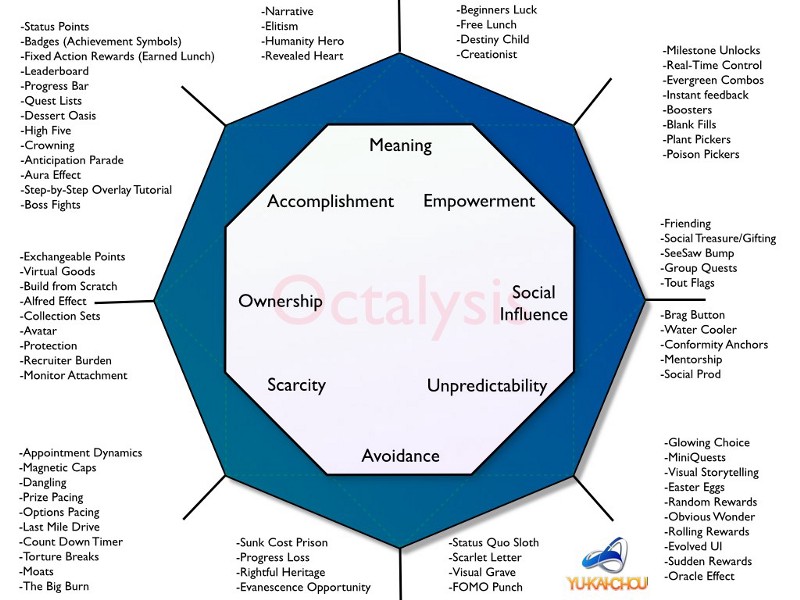Gamification Design in E-Commerce
If you live near a PokeStop, chances are you’ve witnessed first-hand the addictive power of games and gamification. Pokemon GO serves as a poignant reminder that games can drive stratospheric levels of engagement and loyalty.
Not surprisingly, gamification has remained a hot topic among businesses as a way to boost engagement among customers and employees. The gamification market was worth $1.7B in 2015 and is projected to grow to $11B by 2020. However, success remains elusive, with many estimates showing that the majority of gamification projects fail to meet their objectives.
The problem is that many implementations treat gamification as a “quick fix” — adding points, leaderboard, and badges on on app without adequate thought to core user needs and motivations. To be successful, gamification needs to be a thorough, bottoms-up design process of rethinking your app or platform with your customers at the center of that process.
“Gamification is not a project…it’s a program that gets invested in for the long-term. Those that understand that see the most impactful and meaningful results.” — Kris Duggan, founder of Badgeville
My company recently launched a gamified e-commerce app which has quickly developed a thriving online shopping community of 30,000 highly engaged members, many of whom spend hours each day on our platform creating millions of user-generated content assets. We did it by following a bottoms-up process of understanding our users, their motivations, and designing gamified features that effectively tap into these motivations.
What is gamification design in the first place?
“Gamification is the craft of deriving all the fun and addicting elements found in games and applying them to real-world or productive activities” — Yu Kai Chou, gamification expert
You probably have a UX Designer on your team, or at least someone who serves in that capacity. Well, UX = user experience, meaning the UX design process puts the user at the center of the design process.
Gamification takes this one step further and puts human motivation at the center of the design process.
Gamification is the practice of revealing and understanding the underlying motivations of the people who use your app or platform and designing your features to tap into those motivations.
Those motivations might be directly tied to your app’s purpose (members sharing photos on your photos app to connect with friends) or might be unrelated (points system that rewards them with status for doing so). The point is, your app has a complete motivation map — from your welcome screen, onboarding process, all the way through to your daily returning user — that drives your users through your engagement funnel by appealing to the right motivations at each step. You just need to dissect that map and build your app according to its terrain.
In developing our new commerce app, we faced a daunting big data challenge: we wanted to maintain a real-time database of working coupons for 60,000 e-commerce stores, requiring millions of coupons to be updated regularly. How could we achieve this? Crowdsourcing was the obvious answer, and gamification design enabled us to motivate our community of users to help us curate our database with enough frequency, volume, and accuracy to meet our goal of providing a truly delightful deal discovery experience (you can see it in action here: https://dealspotr.com).
We did this using bottoms-up UX design process of identifying our business goals, describing what we wanted our users to do to drive us toward those goals, mapping these activities to our users’ motivations, and designing, prototyping, and iterating on our feature set.
First, identify your business goals and metrics
Implementing a gamification strategy is a complex, multi-step process. You’ll want to clearly define your goals at the outset and reference those as you progress.
What are your goals? To increase sales? Boost traffic? Boost traffic from a specific type of user, or to a specific part of your website or app? Crucially, how will you know whether you’re reaching your goals? What are your success metrics? Be specific, and have a plan for gathering the data you need towards those metrics.
Back to our example, our business goal is to achieve maximum coverage of coupons and deals across 60,000 popular e-commerce stores. This means, at any given time, our app would show the latest, most up-to-date listing of coupons for any of the 60,000 stores in our database, ensuring a great user experience for finding a working deal for any store. While there are many metrics relating to goal, let’s focus on the metric of achieving 10,000 coupon updates per day in our system. If we could achieve 10,000 daily updates, we would be well on our way towards achieving maximum coverage of coupons across all US e-commerce sites.
All the subsequent decisions we made were mapped back to this metric to keep our gamification design process aligned with our business goal.
Next, identify the key user actions that will drive you toward your metrics
If you’re running a photo-sharing app, and your key metric is the number of photos shared per day, then your key user action would be sharing photos — and in gamification parlance you’ll be designing features to motivate your users to take this action.
Using Facebook as a great example of gamification design, one of their stated business goals is to make their news feed a great experience for keeping up with your friends and family. One key metrics to drive toward this goal might be the number of user updates — users posting images, videos, and updates to their news feeds. So they want their users to post more news feed updates. The remainder of their gamification design thinking would involve motivating their users to perform this action.
In our case, to achieve our goal of maximum coupon coverage, we needed our community of users to share deals, so this became our core user action.
Understand your users’ motivations
Motivation is key to driving action. You may have the world’s most beautiful and intuitive photo sharing widget, but if your users are not adequately motivated to post a photo with it every day, your app may fail to reach its goals.
This is where gamification design comes in. Games do a great job of appealing to our motivations. In fact, they’re so good at this that despite the fact that there is no practical benefit to playing (most) games, players still spend hours upon hours playing them. This is because game designers have mastered the art of appealing to player motivations, and this is the same type of thinking we’re going to bring into our business app.
Here’s the key: unlike games, your business app or platform probably has a practical or intrinsic benefit to its use. Employees use your internal dashboard because it is a part of their job, users of your photo sharing app find satisfaction when other people view their photos, people use Facebook to stay in touch with friends. However, in many cases, there are motivation gaps. Employees just login to the dashboard and complete the minimal required tasks, users may only share one photo per month, or Facebook users may only browse their feeds without sharing an update.
Gamification frameworks provide a great map of motivations that you can use to study your users’ motivations. I recommend the popular Octalysis Framework developed by gamification authority Yu Kai Chou, but there are others such as Marczewski’s framework.
In a nutshell, there are left-brain motivations (logic, ownership, analysis) and right-brain motivations (creativity, curiosity, social). Left-brain motivations tend to map to what are called extrinsic rewards which are goal-oriented — concrete, measurable, quantifiable rewards like money, points, status or ownership are extrinsic motivators. Right-brain motivations map to intrinsic rewards which are experience-oriented and are satisfying in and of themselves. Examples include learning, hanging out with friends, adventure, creativity.

Yu Kai Chou’s Octalysis Framework for user motivations
You can bridge motivation gaps in your app by adding game-like elements that appeal to player motivations. The key is to first understand your users through persona development then map out their motivations. Use this motivation map to spot motivation gaps in your current app and then determine whether you can tap into player motivations to create the outcomes you desire.
In Dealspotr’s case, our persona is the prototypical couponer. The budget conscious shopper who places great value on finding a good deal, and will invest time in finding that deal. Our persona development dialed us into some motivators of this type of person — building status and reputation (achievement), collecting things (hoarding), beating the system (camraderie and inside knowledge) helping other people save too (altruism), earning money (productivity), and of course, saving money (frugality).
Design your features
The first question to ask is whether the user actions you have identified are intrinsically motivating. Are you trying to get users to learn something new? Or create stunning images to share with friends? These are inherently motivating activities, so you generally don’t need to add any extrinsic rewards for these.
For our couponer persona, sharing deals is intrinsically motivating. However, to achieve our business goal, we needed our members to share a larger quantity of deals than they would normally share for purely social reasons. So, we designed a points and rewards system to appeal to their motivations of building status, collecting, and productivity and earning money. We also spent time designing our deal sharing tool to be very easy to use, so users could easily post deals in an accurate format.
Prototype, test, iterate, repeat
Once you design your features, you’ll want to prototype them so you can get them in the hands of real users. You probably want to test them with a limited set of users first and get lots of feedback to understand whether your designs are meeting the goals you envisioned. Don’t expect to get it right with your first prototype. Most likely you’ll do several variations based on feedback before you get it right.
As long as you are clear in your goals and have a clear map to how your features align to motivations and actions to drive you towards them, you’re heading in the right direction with gamifying your app or business. It takes time and effort, but the rewards can be great once you succeed.

